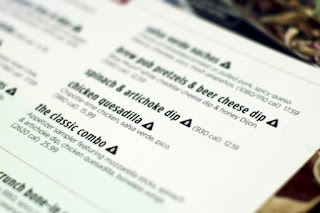Last month, Professor Frediani first brought up the new sodium labeling laws in New York City, I was impressed that New York was taking another step towards health. I did not think too much more about the new labeling in New York until reading another student's blog regarding food labeling in other countries. I decided to revisit the policy change in New York to learn more about the reasons behind the new policy.
For those of you who are not familiar with what change was made, in New York City the government started to require that chain restaurants with to start labeling plates that contain more than 2,3000 mg of sodium. The labeling change was first suggested by the mayor to make the consumers more aware of what was in their foods when eating outside of their home. The labeling change was first passed back in September and would affect restaurants with 15 or more locations in the nation that are located in the city.
An example of a menu with the high sodium symbol
An example of a menu with the high sodium symbol
The main health concern behind consuming that much sodium? The government was mainly focused on trying to make consumers aware that high sodium intake can lead to a greater risk for heart disease and for having a stroke. The daily recommendation for sodium consumption is 2,300 mg, so no one should be consuming their entire daily recommendations from one meal. I think that this is an important step for the health of New Yorkers. It never helps to know more about what is in your food.
Looking into more of the breakdown of where sodium comes from our diet, 77% of sodium comes from foods prepared outside of the home. I thought that this statistic was an important one to learn more about where our sodium is coming from. Restaurants are not only charging us for food, but they are also leading us on a pathway to bad health.
I looked at the updated news regarding the policy change, and it turns out that the restaurants were able to appeal the requirement and the case is currently going through a series of appeals. It will be interesting to see how the results of the case turn out. The lawyer for the city states that he is confident that the policy will be supported based on the fact that in New York there are other similar policies that work in the favor of the people's health. For example, in previous years chain restaurants had to remove all trans-fats from their foods and had to list calories on their menus.
In the past, New York did try to ban soda completely. This policy did not pass, mainly because the Board of Health was making an active attempt to sway consumers from purchasing soda completely, by banning sales of large drink sizes (larger than 16 fl oz). The final court claimed that the Board of Health was acting outside of it's authority.
I think that it will be interesting to see how the sodium labeling appeal case comes out. I see a distinct difference between the two different policies. The main difference between the two policies is that the soda ban was indirectly discouraging consumers from drinking soda, while the sodium labeling policy does not discourage consumers to stop eating out, just to make better choices when it comes to ordering off the menu.
You do not need to have a special label on menus to know how much sodium is in your restaurant meal. Most of the nutrition information is offered on restaurant's websites and with a little research before leaving your house, you can look it up online or even on your smartphone!

This is an interesting proposal. I think that there is definitely a difference between the law addressing soda and the one addressing sodium. I do wonder if having the sodium warning on foods would cause the restaurants to present better options that have less sodium. I also wonder if having this information would really sway people because what is policy without education. I feel like this would only cause us to focus more on the intake of certain nutrients instead of teaching people to eat a more diverse plant-based diet.
ReplyDelete